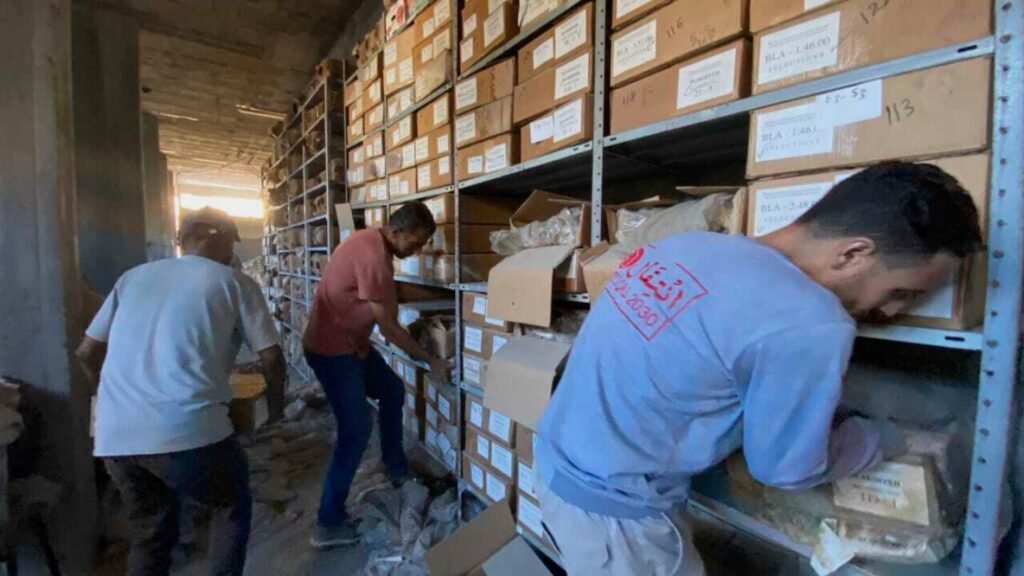Urgent Rescue of Gaza’s Archaeological Heritage Amidst Conflict
Jerusalem (AP) — As conflict escalates in the Gaza Strip, an intense and urgent effort unfolded to protect invaluable archaeological artifacts from the destruction of an Israeli airstrike. This rescue operation was marked by frantic negotiations and a race against time to save pieces of history that hold both cultural and global significance.
The Context of the Rescue Mission
On a Thursday morning, COGAT, Israel’s defense body responsible for humanitarian aid, alerted Première Urgence Internationale (PUI) about the impending demolition of a warehouse containing precious artifacts. This notification came as part of Israel’s broader military operations in Gaza City, intended to neutralize alleged Hamas intelligence installations.
“Artifacts from over 25 years of excavation, including items from a 4th-century Byzantine monastery recognized by UNESCO as a World Heritage Site, were placed in jeopardy,” explained Kevin Charbel, PUI’s emergency field coordinator. According to him, these artifacts are not only critical to Palestinian heritage but represent important global heritage that needs protection.
A Frantic Nine-Hour Negotiation
Charbel spent nearly nine hours negotiating with the Israeli military for a temporary halt on the demolition to allow workers to move the artifacts to a safe location. Despite the urgency, logistical challenges loomed large; as Israeli military operations intensified, it became increasingly difficult to secure transport and resources.
“Five minutes before I had to concede that we would lose everything, we found a transport option,” Charbel recounted, highlighting the precarious nature of their endeavor. Ultimately, PUI, in collaboration with the Latin Patriarchate of Jerusalem, managed to relocate the artifacts to an undisclosed and secure environment in Gaza City.
The Treasures at Risk
The warehouse housed various invaluable items, including ceramics, mosaics, coins, and architectural fragments from the Saint Hilarion Monastery, one of the earliest Christian monastic communities in the Middle East. UNESCO has identified Gaza as a site of extreme archaeological importance, having uncovered numerous ancient sites such as temples, churches, and mosaics that have been lost to urbanization and conflict.
In an area where cultural heritage is continuously under threat, losing these artifacts signifies erasing a crucial part of both Palestinian and global history. The salvaged items serve as a connection to the region’s rich past, dating back thousands of years to when Gaza was a critical hub on trade routes between Egypt and the Levant.
Logistical Challenges and Aftermath
Starting at sunrise, workers hurriedly packed five flatbed trucks with artifacts in a mere six hours. Each carefully documented item, normally requiring meticulous care, was hastily placed in cardboard boxes on the open trucks. Due to military restrictions, covered transport was not an option, exposing the fragile relics to additional threats during transit. Some artifacts were damaged, and others had to be left behind when the storage facility was destroyed soon after the evacuation.
In the wake of the Israeli military campaign, which has included the demolition of numerous high-rise buildings across Gaza, the displaced artifacts have been relocated but remain vulnerable. Current reports indicate that at least 110 cultural sites, including religious places and archaeological sites, have faced destruction amid the ongoing conflict.
Profound Ethical Dilemmas
During the course of this rescue, aid workers grappled with significant ethical dilemmas. Charbel noted the struggle between the needs for humanitarian aid—such as food, water, and medical supplies—and the resources allocated to protecting archaeological artifacts. “Do we direct resources, including fuel, to save inanimate historical objects when the humanitarian situation is so desperate?” he questioned.
Yet, the team felt it was imperative to rescue these artifacts, considering their enormous value. “Preserving early examples of Christian history in Palestine is crucial,” Charbel asserted. “To allow their destruction would mean erasing an essential part of our shared history forever.”
The Bigger Picture
As the conflict in Gaza flares, the urgent protection of cultural heritage remains a pressing issue. International organizations like UNESCO continue to advocate for the preservation of archaeological sites at risk. However, as the humanitarian crisis deepens, the challenge persists in balancing cultural conservation with immediate human needs.
In a climate of uncertainty, the fate of these artifacts reflects broader questions about heritage, identity, and memory—not just for Palestinians but for humanity as a whole. The success and failures of such urgent missions may shape the narrative of history in times of conflict, marking significant intersections of human experience.
For further exploration of Gaza’s archaeological significance, visit UNESCO’s site on cultural heritage.


